NCERT Solutions for Class 12 Maths Chapter 12 Linear Programming
CBSE Class 12th Exam Date:17 Feb' 26 - 17 Feb' 26
Imagine you’re at a supermarket with a fixed budget. Linear Programming helps you decide how many chocolates and how many chips you can buy to be the happiest without overspending. Linear programming is not just about finding the best solution—it’s about understanding the limits of possibility. Linear programming is a mathematical technique that is used for maximising or minimising a linear objective function, subject to a set of linear constraints. These NCERT Solutions for Class 12 Maths will help students learn about the application of the systems of linear inequalities/equations to solve some real-life problems of various types. In real-life situations, a linear programming problem is like getting a maximum profit using limited resources and fulfilling customers' demand without going over budget.
This Story also Contains
- NCERT Solutions for Class 12 Maths Chapter 12 Linear Programming: Download Free PDF
- NCERT Solutions for Class 12 Maths Chapter 12 Linear Programming: Exercise Questions
- Class 12 Maths NCERT Chapter 12: Extra Question
- Linear Programming Class 12 Chapter 12: Topics
- NCERT Class 12 Maths Chapter 12: Important Formulae
- Approach to Solve Questions of Linear Programming Class 12
- Why are Class 12 Maths Chapter 12 Linear Programming Question Answers Important?
- NCERT Solutions for Class 12 Maths: Chapter Wise
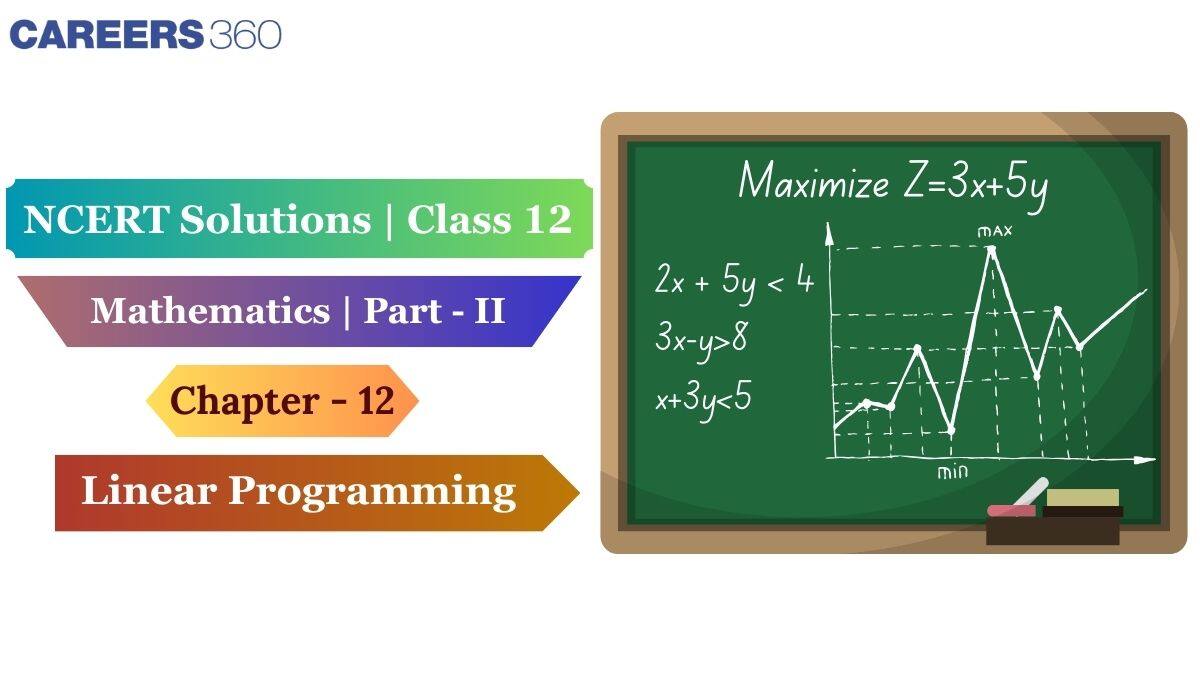
Linear programming teaches us that decisions are not just numbers; they are balanced strategies. The objective of these Class 12 NCERT solutions is to provide students with high-quality study material along with clear explanations of the problems. Many toppers rely on NCERT Solutions since they are designed as per the latest NCERT syllabus. These NCERT Solutions for Class 12 are trustworthy and reliable, as they are created by subject matter experts at Careers360, making them an essential resource for exam preparation. Check this NCERT article for complete syllabus coverage along with NCERT Books, Solutions, Syllabus, and Exemplar Problems with Solutions.
NCERT Solutions for Class 12 Maths Chapter 12
Linear Programming: Download Free PDF
Students who wish to access the Class 12 Maths Chapter 12 NCERT Solutions can click on the link below to download the complete solution in PDF.
NCERT Solutions for Class 12 Maths Chapter 12
Linear Programming: Exercise Questions
Here are the NCERT Class 12 Maths Chapter 12 Linear Programming question answers with clear and detailed solutions.
| Linear Programming Class 12 Question Answers Exercise: 12.1 Page number: 403-404 Total questions: 10 |
Answer:
The region determined by constraints, $x+y\leq 4,x\geq 0,y\geq 0.$ is as follows,
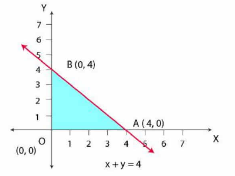
The region A0B represents the feasible region
The corner points of the feasible region are $B(4,0),C(0,0),D(0,4)$
Maximize $Z = 3x + 4y$
The value of these points at these corner points are :
|
Corner points
|
$Z = 3x + 4y$
|
|
|
$B(4,0)$
|
12
|
|
|
$C(0,0)$
|
0
|
|
|
$D(0,4)$
|
16
|
maximum
|
The maximum value of Z is 16 at $D(0,4)$
Answer:
The region determined by constraints, $x+2y\leq 8,3x+2y\leq 12,x\geq 0,y\geq 0.$ is as follows,
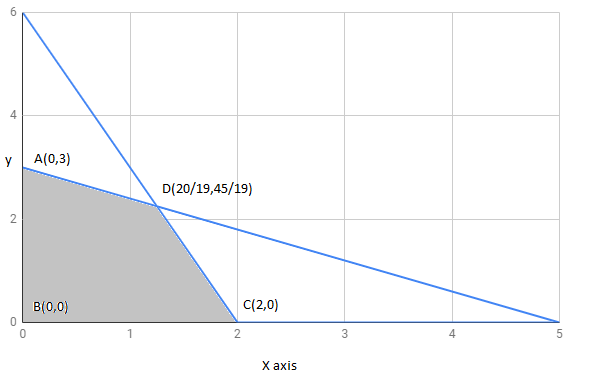
The corner points of feasible region are $A(2,3),B(4,0),C(0,0),D(0,4)$
The value of these points at these corner points are:
|
Corner points
|
$z=-3x+4y$
|
|
|
$A(2,3)$
|
6
|
|
|
$B(4,0)$
|
-12
|
Minimum
|
|
$C(0,0)$
|
0
|
|
|
$D(0,4)$
|
16
|
|
The minimum value of Z is -12 at $B(4,0)$
Answer:
The region determined by constraints, $3x + 5y \leq 15$ , $5x+2y\leq 10$ , $x\geq 0,y\geq 0$ is as follows :
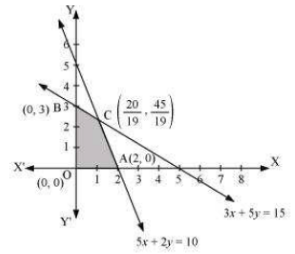
The corner points of feasible region are $A(0,3),B(0,0),C(2,0),D(\frac{20}{19},\frac{45}{19})$
The value of these points at these corner points are :
|
Corner points
|
$Z = 5x + 3y$
|
|
|
$A(0,3)$
|
9
|
|
|
$B(0,0)$
|
0
|
|
|
$C(2,0)$
|
10
|
|
|
$D(\frac{20}{19},\frac{45}{19})$
|
$\frac{235}{19}$
|
Maximum
|
The maximum value of Z is $\frac{235}{19}$ at $D(\frac{20}{19},\frac{45}{19})$
Answer:
The region determined by constraints $x+3y\geq 3,x+y\geq 2,x,y\geq 0.$ is as follows,
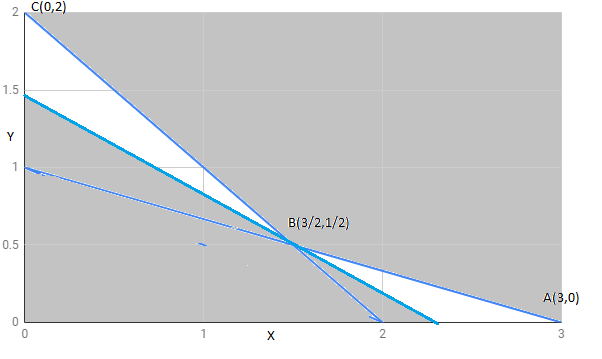
The feasible region is unbounded, as shown.
The corner points of the feasible region are $A(3,0),B(\frac{3}{2},\frac{1}{2}),C(0,2)$
The value of these points at these corner points is:
|
Corner points
|
$Z = 3x + 5y$
|
|
|
$A(3,0)$
|
9
|
|
|
$B(\frac{3}{2},\frac{1}{2})$
|
7
|
Minimum
|
|
$C(0,2)$
|
10
|
|
|
|
|
|
The feasible region is unbounded; therefore, 7 may or may not be the minimum value of Z.
For this, we draw $3x + 5y< 7$ and check whether the resulting half plane has a point in common with the feasible region or not.
We can see that a feasible region has no common point with. $Z = 3x + 5y$
Hence, Z has a minimum value of 7 at $B(\frac{3}{2},\frac{1}{2})$
Answer:
The region determined by constraints, $x+2y\leq 10,3x+y\leq 15,x,y\geq 0$ is as follows,

The corner points of feasible region are $A(5,0),B(4,3),C(0,5)$
The value of these points at these corner points are :
|
Corner points
|
$Z = 3x + 2y$
|
|
|
$A(5,0)$
|
15
|
|
|
$B(4,3)$
|
18
|
Maximum
|
|
$C(0,5)$
|
10
|
|
|
|
|
|
The maximum value of Z is 18 at $B(4,3)$
Answer:
The region determined by constraints $2x+y\geq 3,x+2y\geq 6,x,y\geq 0.$ is as follows,
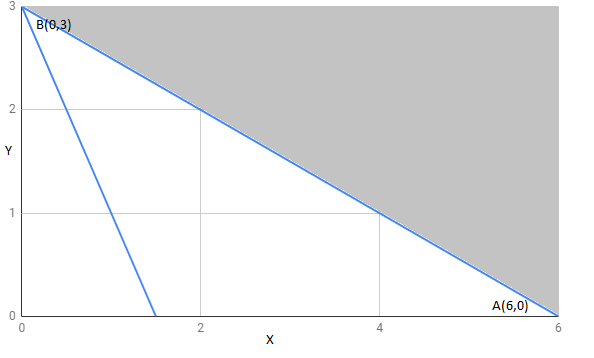
The corner points of the feasible region are $A(6,0),B(0,3)$
The value of these points at these corner points are :
|
Corner points
|
$Z = x + 2y$
|
|
$A(6,0)$
|
6
|
|
$B(0,3)$
|
6
|
The value of Z is the same at both points. $A(6,0),B(0,3)$
If we take any other point like $(2,2)$ on line $Z = x + 2y$, then Z=6.
Thus, the minimum value of Z occurs at more than 2 points.
Therefore, the value of Z is minimum at every point on the line $Z = x + 2y$.
Answer:
The region determined by constraints, $x+2y\leq 120,x+y\geq 60,x-2y\geq 0,x,y\geq 0$ is as follows,
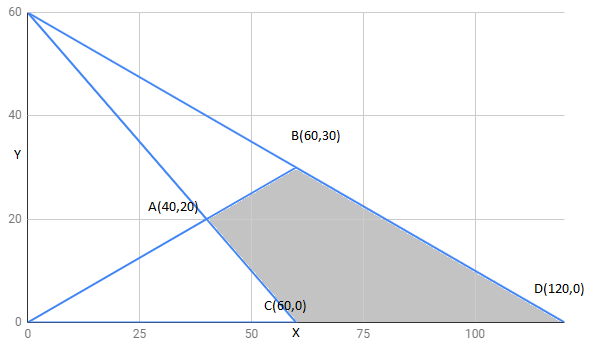
The corner points of feasible region are $A(40,20),B(60,30),C(60,0),D(120,0)$
The value of these points at these corner points are:
|
Corner points
|
$z=5x+10y$
|
|
|
$A(40,20)$
|
400
|
|
|
$B(60,30)$
|
600
|
Maximum
|
|
$C(60,0)$
|
300
|
Minimum
|
|
$D(120,0)$
|
600
|
maximum
|
The minimum value of Z is 300 at $C(60,0)$ and the maximum value is 600 at all points joining line segment $B(60,30)$ and $D(120,0)$
Answer:
The region determined by constraints $x+2y\geq 100,2x-y\leq 0,2x+y\leq 200,x,y,\geq 0$ is as follows,
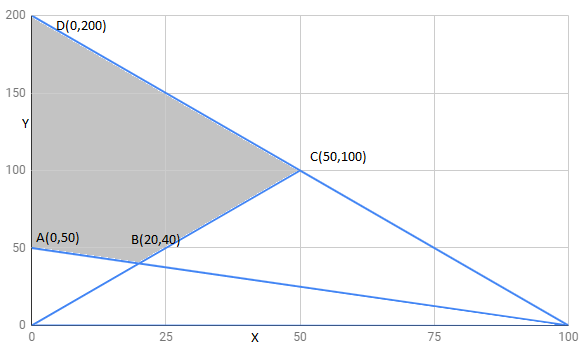
The corner points of the feasible region are $A(0,50),B(20,40),C(50,100),D(0,200)$
The value of these points at these corner points are :
|
Corner points
|
$z=x+2y$
|
|
|
$A(0,50)$
|
100
|
Minimum
|
|
$B(20,40)$
|
100
|
Minimum
|
|
$C(50,100)$
|
250
|
|
|
$D(0,200)$
|
400
|
Maximum
|
The minimum value of Z is 100 at all points on the line segment joining points $A(0,50)$ and $B(20,40)$.
The maximum value of Z is 400 at $D(0,200)$.
Answer:
The region determined by constraints $x\geq 3,x+y\geq 5,x+2y\geq 6,y\geq 0.$ is as follows,

The corner points of the feasible region are $A(6,0),B(4,1),C(3,2)$
The value of these points at these corner points are :
|
Corner points
|
$Z = -x+2y$
|
|
|
$A(6,0)$
|
- 6
|
minimum
|
|
$B(4,1)$
|
-2
|
|
|
$C(3,2)$
|
1
|
maximum
|
|
|
|
|
The feasible region is unbounded; therefore, 1 may or may not be the maximum value of Z.
For this, we draw $-x+2y> 1$ and check whether the resulting half-plane has a point in common with a feasible region or not.
We can see that the resulting feasible region has a common point with the feasible region.
Hence, Z =1 is not the maximum value; Z has no maximum value.
Answer:
The region determined by constraints $x-y\leq -1,-x+ y\leq 0,x,y,\geq 0.$ is as follows,

There is no feasible region, and thus, Z has no maximum value.
Also, read,
Class 12 Maths NCERT Chapter 12: Extra Question
Question: In an LPP, if the objective function $z=a x+b y$ has the same maximum value on two corner points of the feasible region, then the number of points at which $z_{\max }$ occurs is:
Solution:
In an LPP, if the objective function Z = ax + by has the same maximum value on two corner points of the feasible region, then every point on the line segment joining these two points gives the same maximum value. Hence, the number of points at which Zmax occurs is infinite.
Hence, the correct answer is "infinite".
Linear Programming Class 12 Chapter 12: Topics
Here is the list of important topics that are covered in Class 12 Chapter 12 Linear Programming.
- 12.1 Introduction
- 12.2 Linear Programming Problem and its Mathematical Formulation
NCERT Class 12 Maths Chapter 12: Important Formulae
Feasible Region: The feasible region, or solution region, of a linear programming problem is the common area determined by all the constraints, including the non-negativity constraints (x ≥ 0, y ≥ 0).
Infeasible Solution: Any point within or on the boundary of the feasible region represents a feasible solution to the constraints. Points outside the feasible region are considered infeasible solutions.
Optimal Solution: An optimal solution is any point within the feasible region that provides the optimal value (maximum or minimum) of the objective function.
Fundamental Theorems in Linear Programming
Optimality at Corner Points: For a linear programming problem with a feasible region represented as a convex polygon, if the objective function Z = ax + by has an optimal value, this optimal value must occur at one of the corner points (vertices) of the feasible region.
Existence of Maxima and Minima: If the feasible region R is bounded, then the objective function Z has both a maximum and a minimum value on R, and each of these values occurs at a corner point (vertex) of R. If R is unbounded, a maximum or minimum may not exist. However, if it does exist, it must occur at a corner point of R.
Corner Point Method: The corner point method is used to solve a linear programming problem and consists of the following steps:
Find the feasible region of the linear programming problem and determine its corner points (vertices).
Evaluate the objective function Z = ax + by at each corner point. Let M and m represent the largest and smallest values obtained at these points.
If the feasible region is bounded, M and m respectively represent the maximum and minimum values of the objective function.
If the feasible region is unbounded, then:
-
M is the maximum value of the objective function if the open half-plane determined by ax + by > M has no points in common with the feasible region.
-
m is the minimum value of the objective function if the open half-plane determined by ax + by < M has no points in common with the feasible region.
Theorem 1: Let R be the feasible region (convex polygon) for a linear programming problem and let $\mathrm{Z}=a x+b y$ be the objective function. When Z has an optimal value (maximum or minimum), where the variables $x$ and $y$ are subject to constraints described by linear inequalities, this optimal value must occur at a corner point* (vertex) of the feasible region.
Theorem 2: Let R be the feasible region for a linear programming problem, and let $\mathrm{Z}=a x+b y$ be the objective function. If R is bounded ${ }^{* *}$, then the objective function Z has both a maximum and a minimum value on R, and each of these occurs at a corner point (vertex) of $R$.
Approach to Solve Questions of Linear Programming Class 12
Using these approaches, students can tackle the Linear Programming Class 12 Chapter 12 Question Answers with greater confidence.
- Determine whether the problem requires maximisation or minimisation.
- Check if variables are negative or non-negative. If they are non-negative, then they will satisfy a set of linear constraints.
- Plot all the constraints carefully on the graph paper based on their inequalities. Find and shade the feasible region, bounded or unbounded, that satisfies all constraints simultaneously.
- Shortcut tricks: Label all the axes and lines clearly in the graph paper to understand the representation. Be aware of the mistakes made during the plotting or solving of intersections. If the region is unbounded, the optimal value may not exist.
Why are Class 12 Maths Chapter 12 Linear Programming Question Answers Important?
This chapter helps you understand how to make the best possible decisions using maths. It shows how real-life problems can be solved by finding maximum or minimum values. These Class 12 Maths chapter 12 Linear Programming question answers make these ideas easier to learn and apply through step-by-step examples. Here are some more points on why these question answers are important.
- These solutions teach us how to form equations from word problems and solve them using graphs and logical thinking.
- Students learn to apply linear programming to real-world situations such as business, economics, and resource management.
- Dealing with Class 12 Maths chapter 12 Linear Programming question answers builds our problem-solving skills for higher studies and entrance exams.
- It also connects our maths learning to practical fields like data analysis, operations research, and optimisation.
NCERT Solutions for Class 12 Maths: Chapter Wise
Given below is the chapter-wise list of the NCERT Class 12 Maths solutions with their respective links:
Also, read,
- NCERT Exemplar Class 12 Maths Solutions Chapter 12 Linear Programming
- NCERT Notes Class 12 Maths Chapter 12 Linear Programming
NCERT Solutions for Class 12 Subject-wise
Here, you can find the NCERT Solutions for other subjects as well.
- NCERT solutions class 12 chemistry
- NCERT solutions for class 12 physics
- NCERT solutions for class 12 biology
Class-wise NCERT Solutions
Here, you can find the NCERT Solutions for classes 9 to 11.
NCERT Books and NCERT Syllabus
Here, you can find the NCERT books and syllabus for class 12.
Frequently Asked Questions (FAQs)
In Class 12 Maths, Linear Programming finds real-life applications in optimising resource allocation, such as maximising profits or minimising costs in scenarios like production planning, diet planning, and transportation problems.
In Linear Programming Problems (LPP), a feasible solution satisfies all constraints, while an optimal solution is a feasible solution that either maximises or minimises the objective function.
Linear equations and linear inequalities are the types of linear programming problems in NCERT Class 12. The problems in LPP basically consist of the problems that include the calculation of the minimum or maximum value.
There are 10 questions in the Exercise of NCERT Class 12 Maths Chapter 12.
The graphical method is a simple way of solving a Linear Programming Problem (LPP) when there are two decision variables (x and y). This method helps us see the solution of an LPP by drawing the feasible region and checking the objective function at the corners.
Questions related to CBSE Class 12th
On Question asked by student community
Hello,
Since you have passed 10th and 12th from Delhi and your residency is Delhi, but your domicile is UP, here’s how NEET counselling works:
1. Counselling Eligibility: For UP NEET counselling, your UP domicile makes you eligible, regardless of where your schooling was. You can participate in UP state
Hello,
You can access Free CBSE Mock tests from Careers360 app or website. You can get the mock test from this link : CBSE Class 12th Free Mock Tests
Hope it helps !
Yes, it is possible for a student who has done their 12th grade already to take upto 4 exams of their requirement. This is possible through the NIOS, NATIONAL INSTITUTE OF OPEN SCHOOLING. Get more info about the exam and the board through the following link.
For CBSE the PREVIOUS YEARS PAPERS can be accessed through the following link for the Concerned subjec by careers360.
Consequently Careers360 does also have a chapter wise scheme of PYQs, you can access the STUDY MATERIAL (PYQs.) from the following link -
https://school.careers360.com/boards/cbse/cbse-question-bank
Thankyou.
Hello,
Sorry, but JoSAA does not accept marks from two different boards for the same qualification during counselling. However, you can use your NIOS marks to meet the JEE Main/Advanced eligibility criteria if they are better than your CBSE marks. You can use your NIOS marks for the eligibility check,
Applications for Admissions are open.
This ebook serves as a valuable study guide for NEET 2025 exam.
NEET Previous 10 Year Questions
Get nowThis e-book offers NEET PYQ and serves as an indispensable NEET study material.
JEE Main Important Physics formulas
Get nowAs per latest syllabus. Physics formulas, equations, & laws of class 11 & 12th chapters
JEE Main Important Chemistry formulas
Get nowAs per latest syllabus. Chemistry formulas, equations, & laws of class 11 & 12th chapters
JEE Main high scoring chapters and topics
Get nowAs per latest 2024 syllabus. Study 40% syllabus and score upto 100% marks in JEE
JEE Main Important Mathematics Formulas
Get nowAs per latest syllabus. Maths formulas, equations, & theorems of class 11 & 12th chapters
